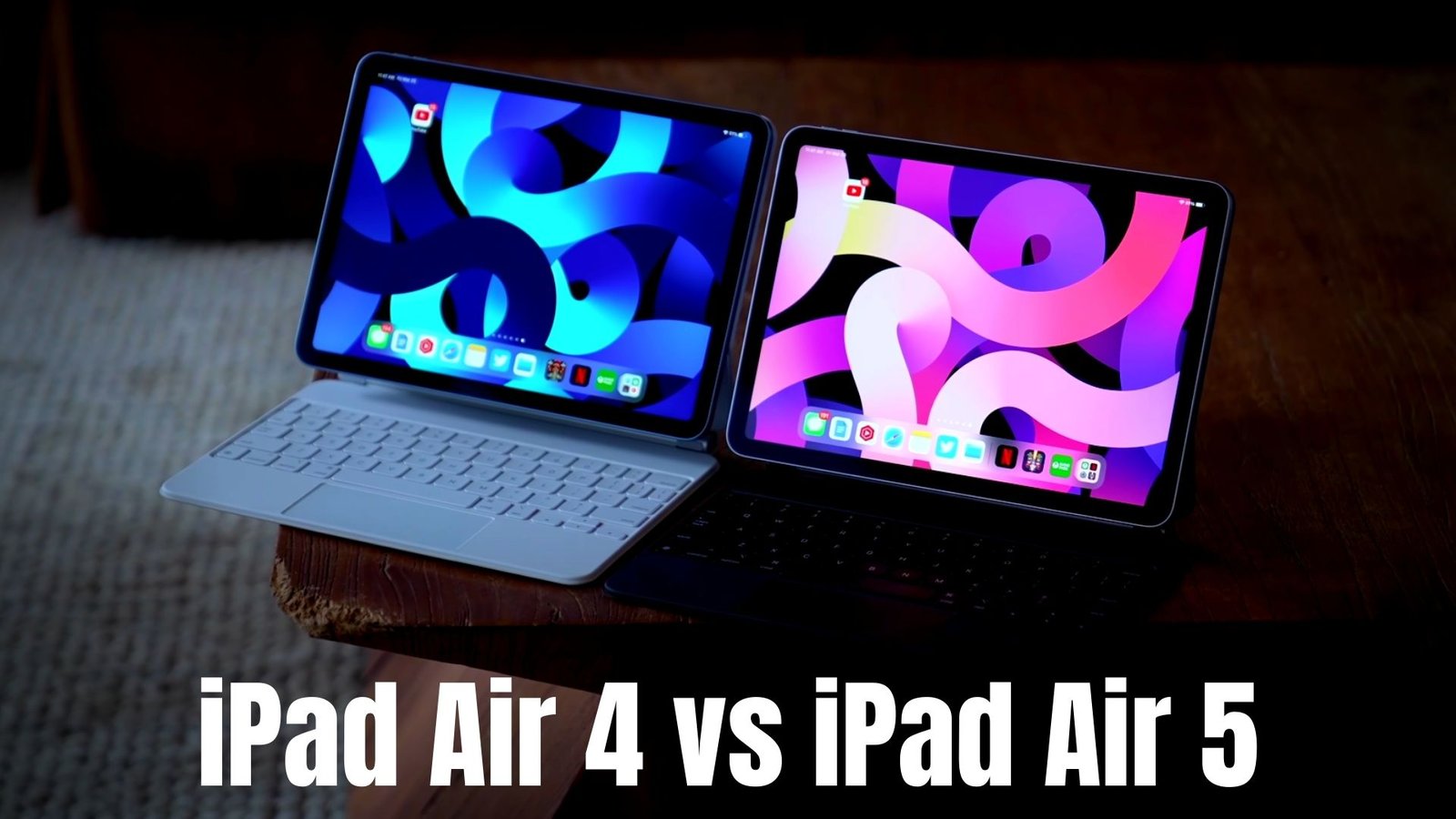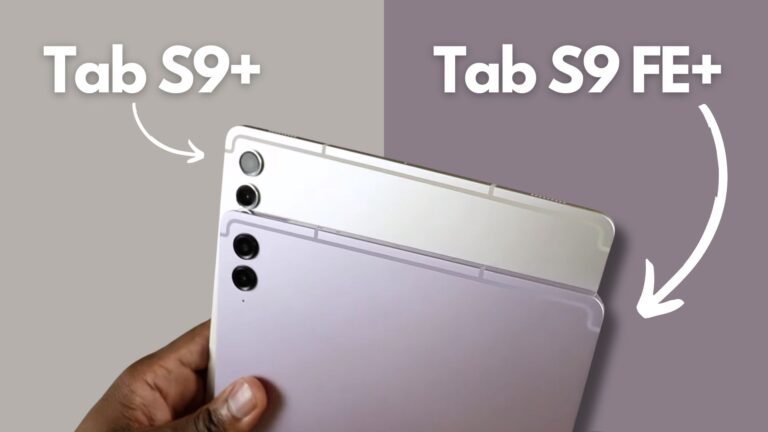When comparing the iPad Air 5 to the iPad Air 4, it’s common to have to double-check to make sure you’re using the right one. Apple did provide some significant updates, but did they go far enough to distinguish the iPad Air 5 from its predecessors?
| iPad Air 4 | iPad Air 5 |
 |  |
| BUY NOW | BUY NOW |
| PROS | PROS |
| ✅ Excellent hardware design. ✅ Strong battery life and USB-C. ✅ Wonderful display. ✅ Pro-level performance. ✅ Magic Keyboard support. ✅ Fast fingerprint sensor. | ✅ High-performance M1 processor. ✅ Slim and light. ✅ Software suitable for work or play. ✅ Large, colorful, and sharp screen. ✅ Wide array of quality accessories. ✅ Center Stage works well. |
| CONS | CONS |
| ⛔ 64GB storage is limited. ⛔ Selfie camera could be better. | ⛔ 64GB storage isn’t enough. ⛔ Battery life disappoints. |
DESIGN AND PORTABILITY
Starting with the dimensions, we have the exact same footprint as the iPad Air 4, with the same body, shape, speaker setup, and button configuration.

As a result, iPad Air 4 cases and accessories will work on the iPad Air 5. If you have the smaller version of the Magic Keyboard, for example, it will work fine. Of course, the 2nd generation Apple Pencil is compatible with both iPads, and the user experience is identical in terms of latency and overall feel.
The port is the one area where we see a difference. Both iPad Air models have a USB-C port, but the one on the iPad Air 5 is faster, capable of 10 gigabits per second versus 5 on the iPad Air 4. Will the vast majority of people care about this now? Most people don’t use that port for anything other than charging, but if you’re connecting an external SSD or a camera and regularly transferring large files to and from your iPads, you’ll appreciate the extra bandwidth.
DISPLAY

Moving on to the display, this was another area where there was room for improvement, but we’re still getting the same liquid retina display with a resolution of 2360 by 1640 pixels, a brightness of 500 nits, and a pixel density of 264 pixels per inch. It’s a P3 display, which means it has excellent colour reproduction and True Tone, which allows it to detect the colour temperature of ambient light and make adjustments to keep the colours looking exactly as they should. The iPad Air 5 maintains the same 60 hertz refresh rate as the iPad Air 4. Adaptive 120 hertz displays are available from Apple, but only on the two iPad Pro models.
CAMERA
When we look at the camera systems, Apple made an upgrade that was absolutely necessary. So the iPad Air 4 still has the older 7 megapixel front-facing camera which made it the worst camera in the entire lineup. Now the iPad Air 5 comes with the new 12 megapixel ultrawide front-facing camera that we see on every other current model.

In addition to being higher resolution, it also brings center stage to the Air 5. Now you may have already seen this feature, but essentially, the ultrawide camera can identify and track a subject as it moves around, and then zoom in and out to make sure that it’s properly framed. If you use your iPad for video calls for work or with your family, this is a great feature.

Now the rear-facing cameras haven’t been updated and it’s still the same 12 megapixel wide camera and Apple didn’t add a flash like they did on the iPad mini 6. So essentially, you’re getting the same features, frame rates and resolutions on the iPad Air 5 that you did on the iPad Air 4. Now the one advantage that I would give the Air 5 is that it’s using the newer ISP or image signal processor on the M1 chip. So this should give it the edge when it comes to overall image quality.
SPEAKERS
We haven’t seen any updates on the speakers as of yet. We still have two speakers, one on each side, with decent audio quality. This was yet another area where Apple could have improved, especially since other tablets in the same price range have four speakers. However, I understand that they had to keep the iPad Air and iPad Pro separate.
BENCHMARKS
Both the 64GB and the 256GB models of the iPad Air 5 come with 8GB of RAM versus 4GB on the iPad Air 4. And as you’d expect, when you look at benchmark scores between the M1 chip on the iPad Air 5 and the A14 Bionic on the Air 4, there’s a significant improvement in performance.
| Single-Core Score | Multi-Core Score | |
| iPad Air 4 | 1594 | 4284 |
| iPad Air 5 | 1720 | 7220 |
Base model of iPad Air 4 and 5 comes with 64GB, which is hard for me to recommend in 2022 unless you’re only using it for content consumption or with relatively small apps. The M1 chip will be just as powerful in five years as it is now. Although there will be plenty of processing power, you will only have 64 gigabytes of storage if you choose this option.
You can use this extra power in a variety of ways, including multitasking. In terms of functionality, both iPads are identical. They’re both running the most recent iPad OS. Split View, Slide Over windows, and the new Multitasking menu are all available.
GAMING
When I compared gaming, I didn’t expect much of a difference, but it was noticeable in some cases. So I started with Asphalt, where I noticed that the gameplay was slightly smoother on the iPad Air 5, but not enough to convince me to upgrade from the iPad 4.
Moving on to PUBG, I didn’t notice any differences; the gameplay was smooth and responsive, and I could use the same graphic settings on both.

I also used the Xbox Game Pass app to pair my Xbox controller and play cloud-based games. Naturally, both iPads handled each game with ease, and the gameplay was very smooth.
PRICING AND FINAL WORDS
We can see that Apple is sticking to their existing model when it comes to configuration options and pricing. I’m going to use the Apple Store prices because they’re consistent, but you can find better deals on other e-commerce sites.
The iPad Air 5 is priced the same as the iPad Air 4, at $599 for 64GB and $749 for 256GB. Both have the same M1 processor and 8GB of RAM, so you’re only paying for the extra storage.
Now, I really wish they had offered 128GB and 512GB models instead, as I believe that would be more in line with current needs, but the fact that an M1 chip can be found in an iPad for $599 is pretty impressive.
Both iPads now have WiFi 6 and Bluetooth 5.0, but the iPad Air 5’s cellular version now has 5G versus 4G on the iPad Air 4.
Overall, the iPad Air 5 is a minor upgrade over the iPad Air 4, and it’s unlikely that most users will want to upgrade. A more powerful chip, twice the RAM, a faster port, a better front-facing camera, and 5G are all included. So, unless you really need those extra features, a 256GB iPad Air 4 for $649 is a better deal than a 64GB iPad Air 5 for $599. You’ll miss out on a few new features in exchange for four times the storage for $50.






